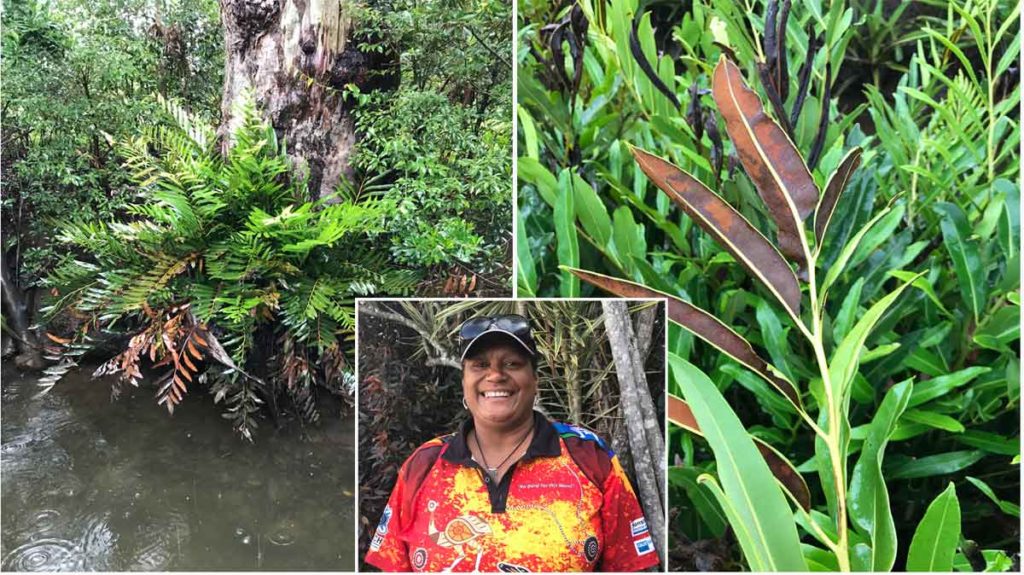Ferns. They grow in lush moss covered rainforests and along the banks of sparkling mountain gullies, right? Not quite.
Ferns are a diverse group of plants that grow in a variety of different ecosystem types, including aquatic, mangroves, coastal heath, eucalypt forest and of course rainforest. Characterised by being a vascular plant that doesn’t produce flowers, fruit or seeds but rather reproduces predominantly by spores.
Walking through an estuarine ecosystem dominated by mangroves, with kingfishers diving above and soldier crabs scuttling below, you could be excused for thinking that the likelihood of seeing a fern is up there with seeing a pig fly. However, the Mangrove Fern (Acrostichum speciosum) is actually a relatively common species of mangrove swamps, riverine estuaries and cliff-faces by the sea. Its distribution in Australia spreads from north-eastern New South Wales all the way along the coast to north-western Western Australia.
This species has leathery, stiff fronds that stand upright to almost 2m in some areas. It has a shallow underground system of modified stems that run horizontally, called rhizomes. These rhizomes become massive in old specimens. Although predominantly an estuarine species, it is not restricted to those ecosystems and has been observed growing at the headwaters of some rivers.

knowledge on the Mangrove Fern. Image on left – Mangrove Fern growing in an estuary
on a Land for Wildlife property at Ninderry. Image on right – spores on fertile fronds. Photos by Danielle Crawford Land for Wildlife Officer Sunshine Coast Council
I spoke to Bridgette Chilli Davis, a Mooloolah Kabi Kabi woman, who kindly told me about her family’s traditional use of the Mangrove Fern:
“The bulbs of the Mangrove Fern stalk were pounded down to make a flour, this was mixed with water, flattened into shape and cooked on rocks in the fire, to make a type of salty flat bread.”
Although the Mangrove Fern tolerates salt water inundation from time to time it tends not to grow in salt water permanently. It also doesn’t mind freshwater inundation and occurs a relatively long way up estuaries.
During a recent Land for Wildlife property visit, I observed the Mangrove Fern growing in clumps along a 600m stretch of a tributary of the North Maroochy River. Where the creek first enters the property, it is dominated by Weeping Lillypilly (Waterhousea floribunda) but by the time it leaves the property, the dominant vegetation is a mix of mangrove species. I undertook some sampling of salinity levels and as expected there is salt water mixing occurring on the property as it changes from near fresh water to salt water. The mangrove fern occurs throughout this stretch of creek, supporting claims in the literature that it tolerates a wide range of salinity levels.
As you can imagine, clumping masses of Mangrove Fern make great refuge for a broad range of fauna that occur in estuarine environments.
The Mangrove Fern is one of the first plants to colonise after a disturbance and often inhabits areas cleared of mangroves. It is particularly valuable for reducing coastal erosion and filtering nutrients and sediment.
Marine plants that grow on or adjacent to tidal lands (including the Mangrove Fern) are protected under the Fisheries Act 1994, and the destruction, damage or disturbance of marine plants is prohibited without prior approval from Fisheries Queensland.
Article and photos by
Danielle Crawford
Land for Wildlife Officer
Sunshine Coast Council

Excellent information thanks.Do you know where I could purchase some of these?
Hi Alan. There are many excellent native plant nurseries in south-east Queensland. Here is a list to just a few http://anpsa.org.au/nursery.html. If you are a member of the Land for Wildlife program, please ask your Land for Wildlife officer details are on pg 2 of our quarterly newsletters at http://www.lfwseq.org.au/newsletters
I have recently purchased a plant from Indigiscapes which is a plant nursery for the Redlands Council.
Gympie Landcare currently stock them 18032022